2019-03-28 - Nº 204
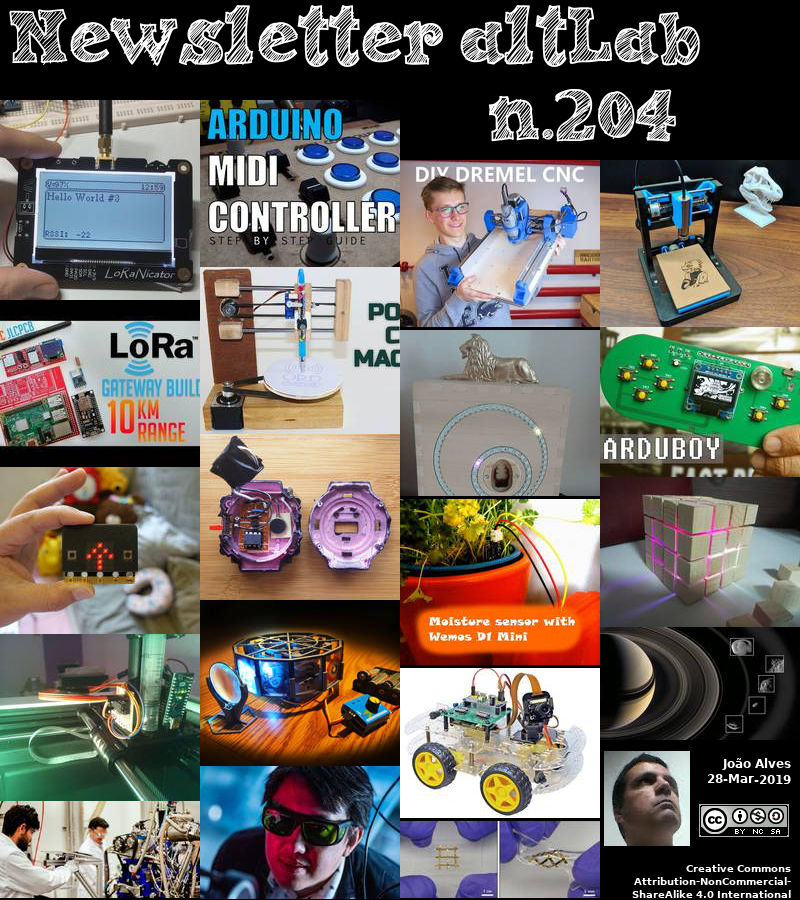
Editorial
Esta é a Newsletter Nº 204 que se apresenta com o mesmo formato que as anteriores. Se gostar da Newsletter partilhe-a!
Todas as Newsletters encontram-se indexadas no link.
Esta Newsletter tem os seguintes tópicos:
Faz anos hoje que nascia, em 1819, Joseph Bazalgette. Este engenheiro civil britânico projectou o sistema de drenagem principal para Londres. Como engenheiro, ele construiu algumas pontes importantes em Londres, mas sua maior realização foi resolver um problema crescente com a poluição por esgoto no rio Tamisa. Em meados do século XIX, tantos londrinos estavam a usar as novas sanitas que o rio estava extremamente poluído com esgoto. A crise do "Grande Fedor" intensificou-se com os surtos de cólera. Bazalgette foi escolhido para projetar e construir o sistema de esgotos de Londres, um projecto de 20 anos. Algumas das suas ideias ainda influenciam a engenharia urbana hoje.
Faz também anos hoje que nascia, em 1897, Victor Mills. Este engenheiro químico americano inventou as fraldas descartáveis. Juntou-se à Proctor & Gamble em 1926, e logo a seguir desenvolveu um processo contínuo para super-aquecer o sabão líquido e pulverizá-lo em forma concentrada através de uma extrusora que produz barras de sabão Ivory. Isto reduziu o tempo de produção de sete dias para apenas algumas horas. Ele melhorou as misturas para bolos da Duncan Hines, passando ingredientes através de grandes tambores de moagem projectados para polir a folha de alumínio, mas tornando o bolo acabado menos encaroçado. Ele desenvolveu um processo para impedir que o óleo se separasse na manteiga de amendoim. A sua invenção de fraldas descartáveis como produto foi criada para utilizar o papel absorvente limpo disponível numa fábrica de celulose adquirida pela empresa.
Faz igualmente anos hoje que nascia, em 1930, Jerome Isaac Friedman. Este Físico americano, junto com Richard E. Taylor e Henry W. Kendall, recebeu o Prémio Nobel de Física em 1990 pela sua confirmação experimental conjunta das partículas fundamentais conhecidas como quarks.
Por fim, faz anos hoje que nascia, em 1939, Dov Frohman. Este engenheiro electrotécnico israelita ficou conhecido por ter inventado a memória leitura programável apagável (EPROM) e também por ser o fundador e primeiro gestor da Intel Israel.
Esta semana ficámos a saber que a sonda Cassini descobriu factos curiosos sobre as cinco pequenas luas que orbitam o planeta Saturno. As superfícies dessas luas estão cobertas com material dos anéis do planeta - e de partículas geladas que saiem disparadas da lua maior de Saturno, Enceladus. O trabalho agora apresentado pinta uma imagem dos processos concorrentes que moldam estas mini-luas.
Esta semana que passou ficámos igualmente a saber que a maior impressora 3D do mundo está a chegar à Arábia Saudita em 2019. Desenvolvida pela empresa dinamarquesa Cobod a impressora pode produzir edifícios de 12x27x9m, bem como estruturas de três andares de 300m2 por andar.
Nesta semana que passou o altLab conjuntamente com alguns membros externos esteve a participar na Hackaton do Pixels Camp 3.0. Foram atingidos os objectivos a que nos comprometemos com o projecto "Open SLAndroid Pixie". Este projecto assenta na construção de uma impressora de Resina (Do tipo SLA) que recorre ao ecrã de um telemóvel obsoleto para apresentar as camadas que têm que ser curadas. Todo o processo é controlado por uma aplicação web que se encontra a correr no próprio telemóvel e que controla a parte mecânica da impressora controlando um Arduino por Bluetooth. Um agradecimento ao esforço dedicação de todos, nomeadamente ao Vinicius, ao João Silva, ao Gustavo, ao Ricardo e ao Rodrigo.
Na Newsletter desta semana apresentamos diversos projetos de maker assim como um modelo 3D que poderá ser útil. São apresentados os livros Inside Azure Management e o "Book of Making volume 1" assim como as revistas MagPI nº 80, newlectronics de 12 e 26 de Março.
 João Alves ([email protected])
João Alves ([email protected])
O conteúdo da Newsletter encontra-se sob a licença  Creative Commons Attribution-NonCommercial-ShareAlike 4.0 International License.
Creative Commons Attribution-NonCommercial-ShareAlike 4.0 International License.
Novidades da Semana

NASA's Cassini Finds Saturn's Rings Coat Tiny Moons
"New findings have emerged about five tiny moons nestled in and near Saturn's rings. The closest-ever flybys by NASA's Cassini spacecraft reveal that the surfaces of these unusual moons are covered with material from the planet's rings - and from icy particles blasting out of Saturn's larger moon Enceladus. The work paints a picture of the competing processes shaping these mini-moons. "The daring, close flybys of these odd little moons let us peer into how they interact with Saturn's rings," said Bonnie Buratti of NASA's Jet Propulsion Laboratory in Pasadena, California. Buratti led a team of 35 co-authors that published their work in the journal Science on March 28. "We're seeing more evidence of how extremely active and dynamic the Saturn ring and moon system is."" [...]
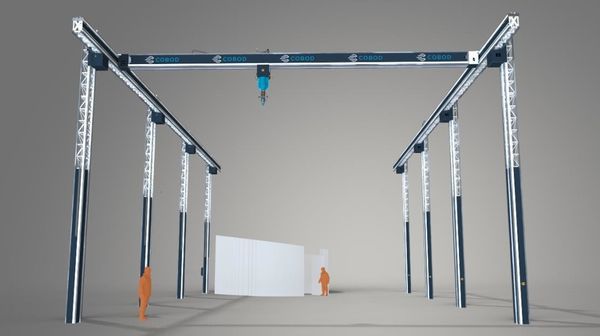
The world's largest 3D printer is coming to Saudi Arabia in 2019
"Danish firm Cobod to deliver Bod 2 printer to Saudi Arabian builder Elite for Construction & Development Co in Q2 2019 Saudi Arabia's Elite for Construction & Development Company has purchased what has been described as the world’s largest 3D construction printer from Danish firm Cobod International. The Bod 2 printer can produce buildings of 12x27x9m buildings, as well as three-storey structures of 300m2 per floor. Cobod said in a statement that its printer will be delivered in Saudi Arabia by the end of May, adding that the machine will be the "first of its kind" in the kingdom. Copenhagen-based Codod, a sister company of 3D Printhuset, manufactured Europe’s first 3D printed building in Europe, the Bod, in 2017. A year later saw it launch Bod 2. In 2018, Germany's Peri Group acquired a minority stake in Cobod." [...]
Outras Notícias
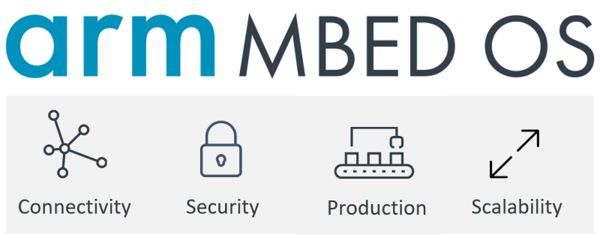
Mbed OS 5.12 Release: Focus on Security and Connectivity
"Arm recognizes how security and efficiency are key concerns for developers creating IoT devices, which is why Arm’s latest release of Mbed OS, Mbed OS 5.12, ushers in Platform Security Architecture (PSA) support. This latest addition builds upon previous advances, such as Mbed TLS and Pelion Device Management by incorporating the industry standard for practical, accessible device life cycle security. Other features include: Platform Security Architecture (PSA) Additional security and partitioning offer greater resilience without adding complexity or the need to amend a single line of code. Plus, it can run on any processor with the same APIs because PSA is not architecture specific. PSA cryptography Main firmware developers can now carry out cryptographic operations behind the security wall without having to deal with cryptographic key material directly. PSA delineates cryptography API between end users and a lower level device driver API, meaning developers can augment crypto algorithms without having to modify the API itself." [...]
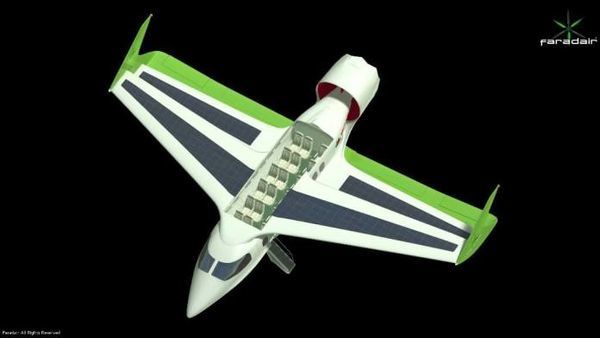
Faradair announces hybrid electric commercial flight capability from 2025
"Faradair®, has revealed its intention to certify its revolutionary 18 seat, hybrid electric ‘BEHA’ aircraft (Bio Electric Hybrid Aircraft) by 2025 for passenger operations. Designated the BEHA_M1H, this hybrid powered aircraft utilises a design patented ‘Triple Box-wing’ high-lift configuration, delivering Short Take-Off and Landing (STOL) capability requiring less than 300 meters of runway. With twin contra-rotating ‘propfans’ within a vectored thrust, acoustic reduction duct that improves efficiency and reduces noise to a target of just 60dba at take-off. After four years of development, both simulated and scale model testing, the design has evolved into a utilitarian configuration, capable of carrying 18 passengers or three LD3 cargo containers, with an internal payload capability of FIVE TONNES. The aircraft will be able to change configuration in 15 minutes from cargo to passenger and vice versa and the company is already in discussion with potential civilian and non-civilian customers for this class leading capability. London to Manchester could be flown in just 42 minutes at a cruise speed of 230mph (HS2 would take 1hour and 8 minutes by comparison) As one of the earliest hybrid electric aerospace start-up’s founded in 2014, UK based Faradair® has had to survive on angel investment funding and partner input in order to develop its new aircraft design." [...]
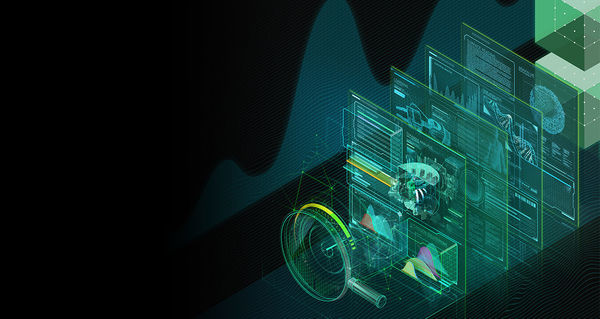
How AI, Machine Learning Are Advancing Academic Research
"Academics are taking up GPUs, data science and AI to advance research. Insulin. The polio vaccine. The periodic table of elements. Countless discoveries across every field of research have their origins in academia. Universities and research institutes around the world are key drivers of discovery and innovation, with professors and researchers looking for answers to the biggest questions facing each academic discipline." [...]
Ciência e Tecnologia
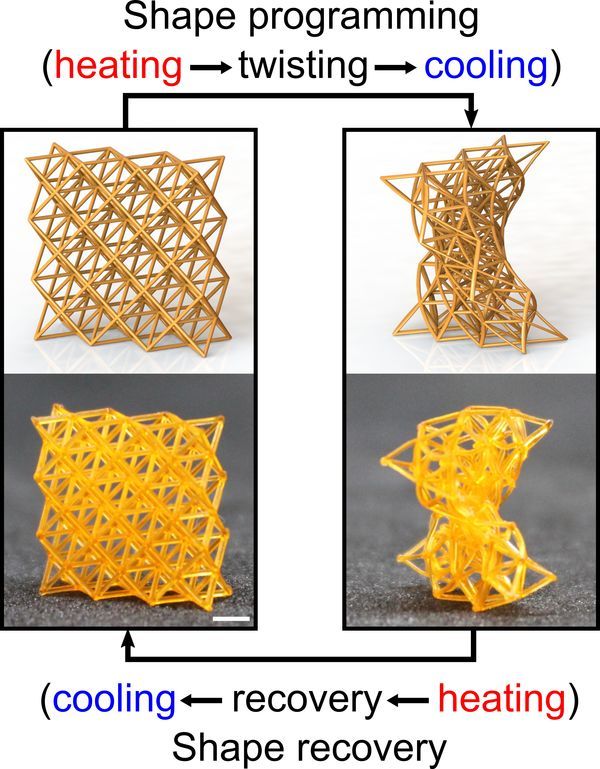
4D-Printed Materials Can Be Stiff as Wood or Soft as Sponge
"Rutgers engineers’ unique smart materials change shape as temperatures change Imagine smart materials that can morph from being stiff as wood to as soft as a sponge – and also change shape. Rutgers University–New Brunswick engineers have created flexible, lightweight materials with 4D printing that could lead to better shock absorption, morphing airplane or drone wings, soft robotics and tiny implantable biomedical devices. Their research is published in the journal Materials Horizons. 3D printing, also known as additive manufacturing, turns digital blueprints to physical objects by building them layer by layer. 4D printing is based on this technology, with one big difference: it uses special materials and sophisticated designs to print objects that change shape with environmental conditions such as temperature acting as a trigger, said senior author Howon Lee, an assistant professor in the Department of Mechanical and Aerospace Engineering. Time is the fourth dimension that allows them to morph into a new shape." [...]
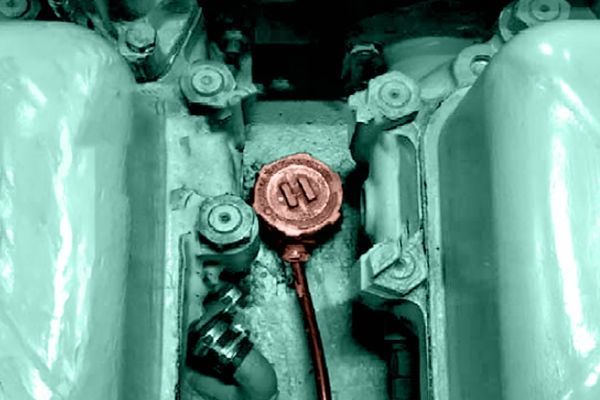
Energy monitor can find electrical failures before they happen
"Sensor can monitor wiring in a building or ship, and signal when repairs are needed. A new system devised by researchers at MIT can monitor the behavior of all electric devices within a building, ship, or factory, determining which ones are in use at any given time and whether any are showing signs of an imminent failure. When tested on a Coast Guard cutter, the system pinpointed a motor with burnt-out wiring that could have led to a serious onboard fire. The new sensor, whose readings can be monitored on an easy-to-use graphic display called a NILM (non-intrusive load monitoring) dashboard, is described in the March issue of IEEE Transactions on Industrial Informatics, in a paper by MIT professor of electrical engineering Steven Leeb, recent graduate Andre Aboulian MS ’18, and seven others at MIT, the U.S. Coast Guard, and the U.S. Naval Academy. A second paper will appear in the April issue of Marine Technology, the publication of the Society of Naval Architects and Marine Engineers." [...]
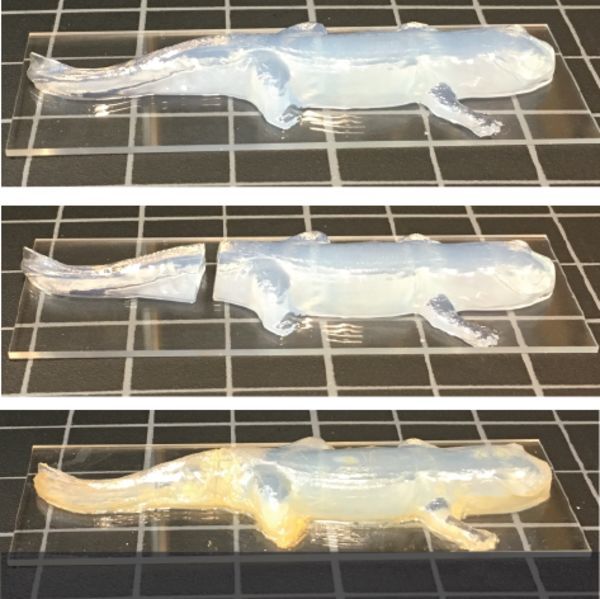
Dynamic hydrogel used to make 'soft robot' components and LEGO-like building blocks
"A new type of hydrogel material developed by Brown University researchers could soon make assembling complex microfluidic or soft robotic devices as simple as putting together a LEGO set. Using a new type of dual polymer material capable of responding dynamically to its environment, Brown University researchers have developed a set of modular hydrogel components that could be useful in a variety of “soft robotic” and biomedical applications. The components, which are patterned by a 3D printer, are capable of bending, twisting or sticking together in response to treatment with certain chemicals. For a paper published in the journal Polymer Chemistry, the researchers demonstrated a soft gripper capable of actuating on demand to pick up small objects. They also designed LEGO-like hydrogel building blocks that can be carefully assembled then tightly sealed together to form customized microfluidic devices — “lab-on-a-chip” systems used for drug screening, cell cultures and other applications. The key to the new material’s functionality is its dual polymer composition, the researchers say." [...]
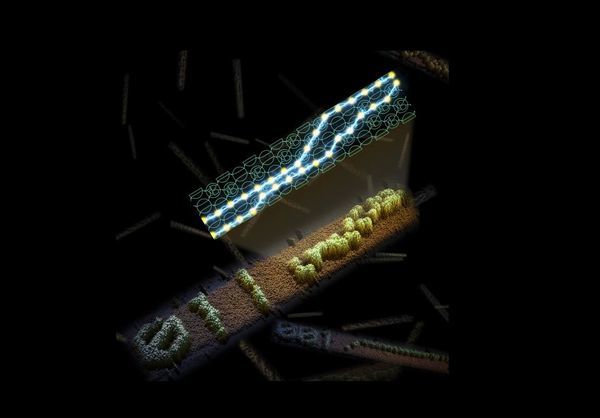
Computer Scientists Create Programmable Self-Assembling DNA
"Computer scientists at the University of California, Davis, and the California Institute of Technology have created DNA molecules that can self-assemble into patterns essentially by running their own program. The work is published March 21 in the journal Nature. “The ultimate goal is to use computation to grow structures and enable more sophisticated molecular engineering,” said David Doty, assistant professor of computer science at UC Davis and co-first author on the paper. The system is analogous to a computer, but instead of using transistors and diodes, it uses molecules to represent a six-bit binary number (for example, 011001). The team developed a variety of algorithms that can be computed by the molecules. "We were surprised by the versatility of algorithms we were able to design, despite being limited to six-bit inputs," Doty said." [...]

Kicking neural network design automation into high gear
"Algorithm designs optimized machine-learning models up to 200 times faster than traditional methods. A new area in artificial intelligence involves using algorithms to automatically design machine-learning systems known as neural networks, which are more accurate and efficient than those developed by human engineers. But this so-called neural architecture search (NAS) technique is computationally expensive. A state-of-the-art NAS algorithm recently developed by Google to run on a squad of graphical processing units (GPUs) took 48,000 GPU hours to produce a single convolutional neural network, which is used for image classification and detection tasks. Google has the wherewithal to run hundreds of GPUs and other specialized hardware in parallel, but that’s out of reach for many others. In a paper being presented at the International Conference on Learning Representations in May, MIT researchers describe an NAS algorithm that can directly learn specialized convolutional neural networks (CNNs) for target hardware platforms — when run on a massive image dataset — in only 200 GPU hours, which could enable far broader use of these types of algorithms." [...]
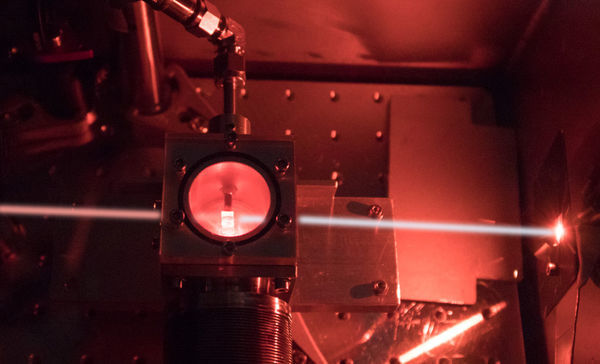
Researchers generate the shortest ultraviolet laser pulse ever
"Researchers at the Center for Free-Electron Laser Science (CFEL) have generated a 1.9-femtosecond ultraviolet laser light pulse – setting arecord for ultraviolet (UV) laser pulses with the shortest duration. The experiments, published in the recent issue of the scientific journal Optics Letters, outshine the previous record of 2.8 femtoseconds, set in 2010. The 1.9-femtosecond pulse (1 femtosecond is a millionth of a billionth of a second) has been generated in the laboratory of Prof. Francesca Calegari (Universität Hamburg, DESY) head of the attosecond science group at CFEL and member of the cluster of excellence CUI: Advanced Imaging of Matter. It covers the very relevant spectral region between 210 and 340 nanometres (nm), corresponding to the so-called UVB and UVC energy ranges. UVB radiation contained in the solar emission partially penetrates our atmosphere, thus triggering a number of bio-chemically relevant processes including damage of the DNA, leading to skin cancer. These processes are often based on ultrafast mechanisms that require extremely short light pulses to be captured in real time." [...]
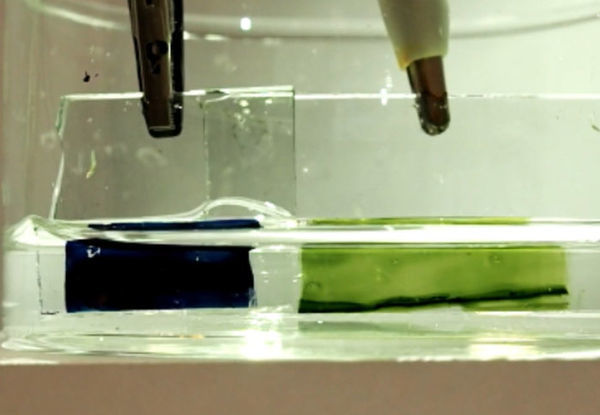
Non-toxic salt water battery prototype can charge in seconds
"A battery prototype has been designed using salt water and materials that are non-toxic and charge quickly, paving the way for new types of battery. The design principles behind the new prototype, which changes colour as it charges, could also be applied to existing battery technologies to create new devices for energy storage, biological sensing, and smart colour-changing materials. The most widely used batteries currently are lithium-ion batteries, which have a relatively high capacity (they hold a large amount of charge) but do not discharge or recharge their energy quickly. They also contain organic electrolytes and other materials that can be hazardous and flammable, meaning they require careful handling and disposal. The new battery prototype, developed by a team of researchers from the departments of Physics and Chemistry at Imperial College London, uses thin films of specially designed plastics and simple salt water instead. While it can hold less charge than conventional lithium-ion batteries, the prototype, which is made from polymers – long chains of molecules that make up plastics – can charge and discharge in a matter of seconds." [...]
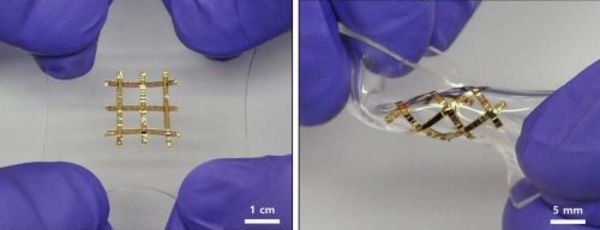
The Future of Stretchable Electronics
"Stretchable devices could have a wide range of potential uses, from wearable health monitors to elastic solar cells to artificial skin Tsukuba, Japan, Mar 24, 2019 - (ACN Newswire) - Stretchable electronics is emerging as a promising new technology for next-generation wearable devices, according to a review published in Science and Technology of Advanced Materials. The technology has many possible applications for healthcare, energy and the military. But there are several challenges involved in finding suitable materials and manufacturing methods. The biggest challenge for making stretchable electronics is that each component must endure being compressed, twisted and applied to uneven surfaces while maintaining performance, according to the review author Wei Wu, materials scientist at Wuhan University, China. Many different stretchable electronic components are being developed. For instance, low-cost stretchable conductors and electrodes are being made from silver nanowires and graphene." [...]
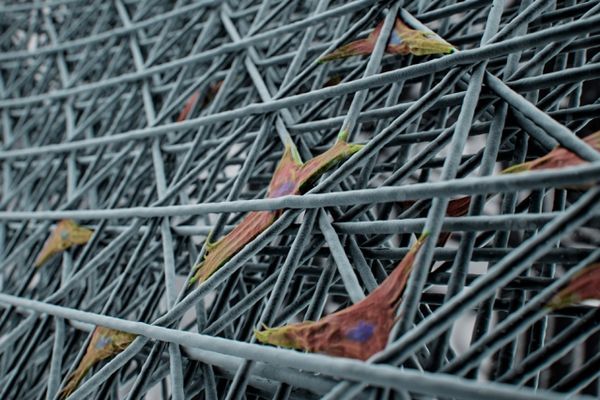
New 3-D printing approach makes cell-scale lattice structures
"System could provide fine-scale meshes for growing highly uniform cultures of cells with desired properties. A new way of making scaffolding for biological cultures could make it possible to grow cells that are highly uniform in shape and size, and potentially with certain functions. The new approach uses an extremely fine-scale form of 3-D printing, using an electric field to draw fibers one-tenth the width of a human hair. The system was developed by Filippos Tourlomousis, a postdoc at MIT’s Center for Bits and Atoms, and six others at MIT and the Stevens Institute of Technology in New Jersey. The work is being reported today in the journal Microsystems and Nanoengineering. Many functions of a cell can be influenced by its microenvironment, so a scaffold that allows precise control over that environment may open new possibilities for culturing cells with particular characteristics, for research or eventually even medical use." [...]
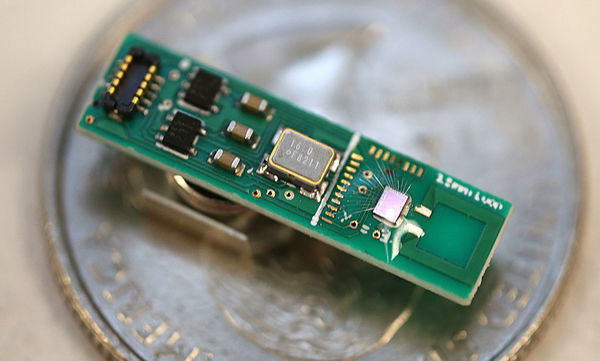
Teeny-Tiny Bluetooth Transmitter Runs on Less Than 1 Milliwatt
"Bluetooth Low Energy data packets can now be sent by millimeter-size IoT motes You’re probably swimming in Bluetooth radio signals right now. But none of those are coming from the smallest, lowest-power end of the Internet of Things. These battery-powered and energy-harvesting millimeter-scale sensors are meant to last for years without needing replacement, but their radios can’t muster the energy needed to communicate using even the lowest energy version of Bluetooth, called Bluetooth Low Energy (BLE). Engineers at the University of Michigan have now built the first millimeter-scale stand-alone device that speaks BLE. Consuming just 0.6 milliwatts during transmission, it would broadcast for 11 years using a typical 5.8-millimeter coin battery. Such a millimeter-scale BLE radio would allow these ant-size sensors to communicate with ordinary equipment, even a smartphone." [...]
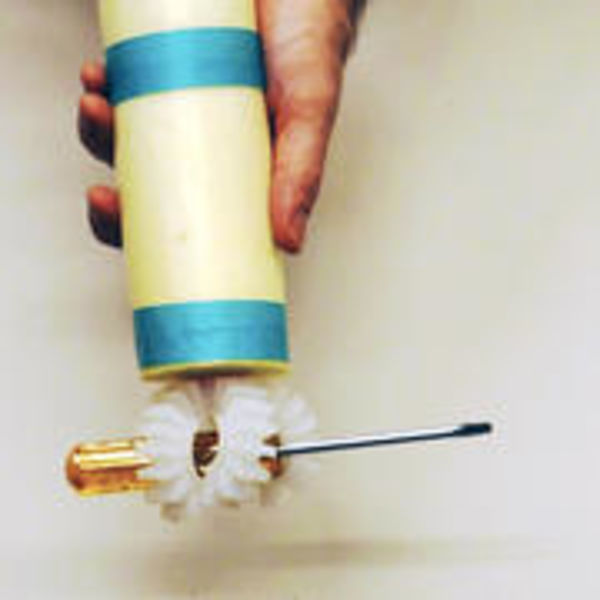
A rubber computer eliminates the last hard components from soft robots
"Soft digital logic emulates the thought process of an electronic computer and the feel of a human hand A soft robot, attached to a balloon and submerged in a transparent column of water, dives and surfaces, then dives and surfaces again, like a fish chasing flies. Soft robots have performed this kind of trick before. But unlike most soft robots, this one is made and operated with no hard or electronic parts. Inside, a soft, rubber computer tells the balloon when to ascend or descend. For the first time, this robot relies exclusively on soft digital logic. In the last decade, soft robots have surged into the metal-dominant world of robotics." [...]
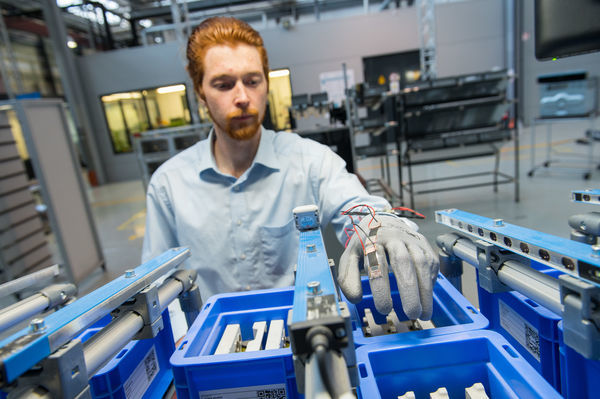
Smart glove for Industry 4.0: Connecting the physical hand to the virtual world
"Researchers at Saarland University have created an ultrathin flexible film that can act as a sensor for innovative technologies. Integrated within a glove, the new sensory film can communicate the current position of the wearer’s hand and fingers. By establishing a direct connection between the virtual and real working worlds, man and machine can, quite literally, work hand in hand. The research team led by Professor Stefan Seelecke has achieved this through the use of smart silicone films. Another goal of the research work is to assist the wearer of the glove by transmitting tactile signals, such as pulses or vibrations, that are produced by the polymer film. The team of engineers will be at Hannover Messe from the 1st to the 5th of April at the Saarland Research and Innovation Stand (Hall 2, Stand B46), where they will be showcasing the prototype glove and looking for partners with whom they can develop the technology for practical applications." [...]
A new spin on organic semiconductors
"Researchers have found that certain organic semiconducting materials can transport spin faster than they conduct charge, a phenomenon which could eventually power faster, more energy-efficient computers. Organic semiconductors have not been realistic candidates for spintronics so far because it was impossible to move spins far enough without losing the original information Deepak Venkateshvaran The international team from the UK, Germany and the Czech Republic, have found that these materials could be used for ‘spintronic’ applications, which could make cheap organic semiconductors competitive with silicon for future computing applications. The results are reported in the journal Nature Electronics. ‘Spin’ is the term for the intrinsic angular momentum of electrons, which is referred to as up or down. Using the up/down states of electrons instead of the 0 and 1 in conventional computer logic could transform the way in which computers process information. Instead of moving packets of charge around, a device built on spintronics would transmit information using the relative spin of a series of electrons, known as a pure spin current." [...]
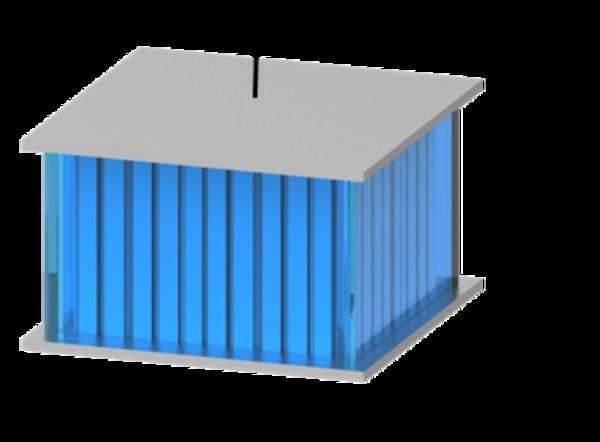
UMD Researchers Wood-based Technology Creates Electricity from Heat
" A University of Maryland-led team of researchers has created a heat-to-electricity device that runs on ions and which could someday harness the body’s heat to provide energy. Led by UMD researchers Liangbing Hu, Robert Briber and Tian Li of the department of materials science, and Siddhartha Das of mechanical engineering, the team transformed a piece of wood into a flexible membrane that generates energy from the same type of electric current (ions) that the human body runs on. This energy is generated using charged channel walls and other unique properties of the wood’s natural nanostructures. With this new wood-based technology, they can use a small temperature differential to efficiently generate ionic voltage, as demonstrated in a paper published March 25 in the journal Nature Materials. If you’ve ever been outside during a lightning storm, you’ve seen that generating charge between two very different temperatures is easy. But for small temperature differences, it is more difficult." [...]
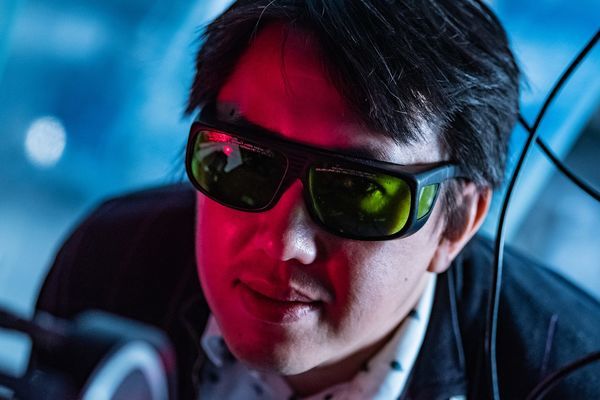
Matter waves and quantum splinters
"Physicists in the United States, Austria and Brazil have shown that shaking ultracold Bose-Einstein condensates (BECs) can cause them to either divide into uniform segments or shatter into unpredictable splinters, depending on the frequency of the shaking. “It’s remarkable that the same quantum system can give rise to such different phenomena,” said Rice University physicist Randy Hulet, co-author of a study about the work published online today in the journal Physical Review X. Hulet’s lab conducted the study’s experiments using lithium BECs, tiny clouds of ultracold atoms that march in lockstep as if they are a single entity, or matter wave. “The relationship between these states can teach us a great deal about complex quantum many-body phenomena.” The research was conducted in collaboration with physicists at Austria’s Vienna University of Technology (TU Wien) and Brazil’s University of São Paulo at São Carlos. The experiments harken to Michael Faraday‘s 1831 discovery that patterns of ripples were created on the surface of a fluid in a bucket that was shaken vertically at certain critical frequencies. The patterns, known as Faraday waves, are similar to resonant modes created on drumheads and vibrating plates. To investigate Faraday waves, the team confined BECs to a linear one-dimensional waveguide, resulting in a cigar-shaped BEC." [...]
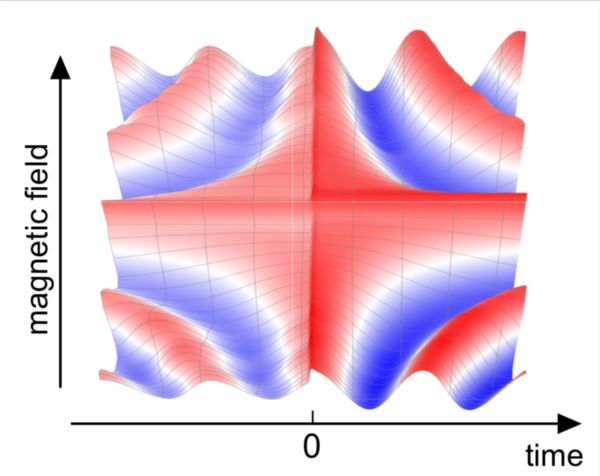
Controlling Nuclear Noise in Semiconductor Qubits
"When it comes to quantum computation, superconducting qubits are currently leading the field. But there are other ways to represent a qubit. The spin of an electron is arguably a much simpler object than a superconducting circuit: In a straightforward way, spin up and spin down represent the two qubit states, 0 and 1. However, also for spin qubits, the stored quantum information does not persist forever. The electrons interact with their environment and thereby lose their spin polarization over time. Electron spins are typically captured on semiconductor “islands” (so-called quantum dots) that consist of more than 100,000 atoms." [...]
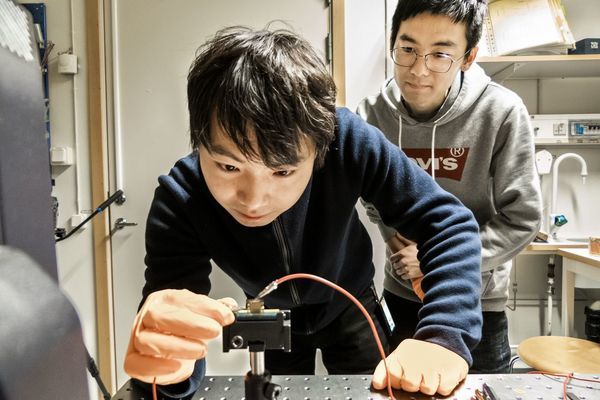
Record efficiency for perovskite-based light-emitting diodes
"Efficient near-infrared (NIR) light-emitting diodes of perovskite have been produced in a laboratory at Linköping University. The external quantum efficiency is 21.6%, which is a record. The results have been published in Nature Photonics. The work is led by LiU scientist Feng Gao, in close collaboration with colleagues in China, Italy, Singapore and Switzerland. Perovskites are a group of materials defined by their crystal structure, and have been the focus of intense research interest during the past 10 years, initially for solar cells and recently also for light emitting diodes. They have good light-emitting properties and are easy to manufacture." [...]
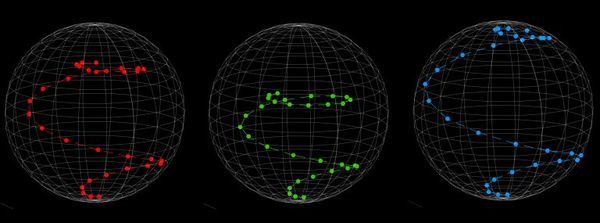
Noise Amplification Squeezes More Computational Accuracy From Today's Quantum Processors
"Conventional wisdom holds that two wrongs don’t make a right. However counter intuitive this may seem, many wrongs could be the key to improving the performance of noisy quantum computers today. The problem Computers that rely on the power of quantum mechanical phenomena to perform calculations are also extremely susceptible to “noise” from their environment – which leads to errors in the computation. Even at the extreme cold temperatures of a dilution refrigerator where the quantum processors operate, our physical computing elements, superconducting qubits, have coherence times on the order of a few hundred microseconds at best, which sets the timescales over which quantum information is lost. While a major challenge to advancing quantum computers today involves increasing these qubit coherence times, the end goal is to build a fully fault tolerant quantum computer capable of detecting and correcting errors. However, these architectures are likely several years away." [...]
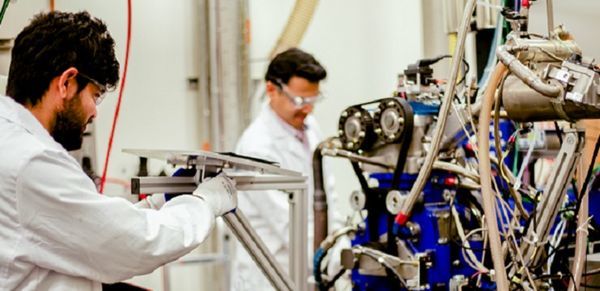
Turbocharging the switch to efficient engines
"Predicting capricious pre-ignition combustion events could enable automakers to build powerful yet more efficient engines. A combustion problem that has troubled engine manufacturers since the industry began still plagues the designers of fuel-efficient engines. A team at KAUST’s Clean Combustion Research Center, led by Robert Dibble, focuses on understanding pre-ignition. A single occurrence of pre-ignition—when fuel ignites prematurely in the engine cylinder to release a mistimed kick of energy—can cause major damage. Pre-ignition is sporadic and unpredictable. It is more prevalent in the downsized, turbocharged engines that car makers are now producing for improved fuel efficiency while maintaining power output." [...]
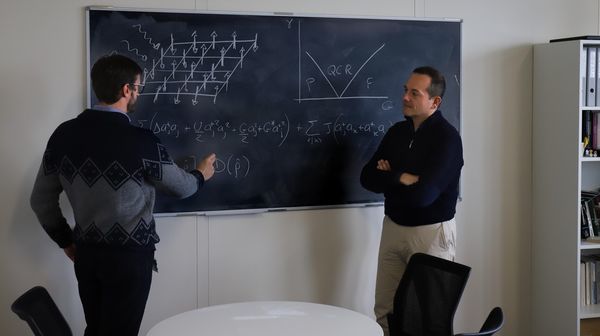
In a new quantum simulator, light behaves like a magnet
"Physicists at EPFL propose a new “quantum simulator”: a laser-based device that can be used to study a wide range of quantum systems. Studying it, the researchers have found that photons can behave like magnetic dipoles at temperatures close to absolute zero, following the laws of quantum mechanics. The simple simulator can be used to better understand the properties of complex materials under such extreme conditions. When subject to the laws of quantum mechanics, systems made of many interacting particles can display behaviour so complex that its quantitative description defies the capabilities of the most powerful computers in the world. In 1981, the visionary physicist Richard Feynman argued we can simulate such complex behavior using an artificial apparatus governed by the very same quantum laws – what has come to be known as a “quantum simulator”. One example of a complex quantum system is that of magnets placed at really low temperatures." [...]
Modelos 3D
Com a disponibilidade de ferramentas que permitem dar azo a nossa imaginação na criação de peças 3D e espaços como o thingiverse para as publicar, esta rubrica apresenta alguns modelos selecionados que poderão ser úteis.
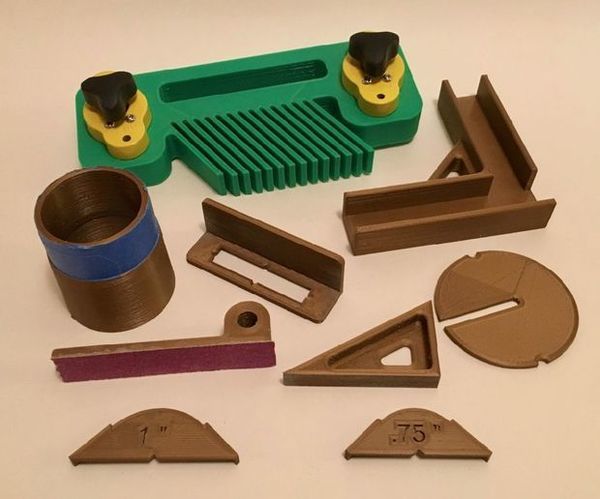
3D Printed Gadgets for Woodworking
"This is a collection of simple 3D printed gadgets for my woodworking workshop. All where designed in Autodesk Fusion 360, and I have included the stl files so you can print your own. The designs are pretty simple, so it should not be difficult for you to modify any of the parts. " [...]
Documentação
A documentação é parte essencial do processo de aprendizagem e a Internet além de artigos interessantes de explorar também tem alguma documentação em formato PDF interessante de ler. Todos os links aqui apresentados são para conteúdo disponibilizado livremente pelo editor do livro.

The MagPI 80
"Discover the 50 best Raspberry Pi tips in this month’s edition of The MagPi. The team has come together to offer a definitive collection of hacks, hints, and tricks. Covering Raspbian, security, coding, making, networking, and the command line. This is a definitive collection of essential advice for any Raspberry Pi maker. Plus! All this inside The MagPi 80 Amazing ham radio projects Use ham radio with Raspberry Pi Hack a Lego Boost Use a Raspberry Pi device to control your Lego projects Set up a Samba file server Quickly build a Raspberry Pi network file-storage device Build a karaoke machine Sing your heart out with this great Raspberry Pi project Make comic books from TV recordings Automatically turn video recordings into mock hand-drawn comic books The top 10 HATs The best Hardware Attached on Top accessories for Raspberry Pi Learn the command line A great selection of resources for anybody looking to boost their command-line skills Underwater drone How one reader has built a remote-control underwater robot The Clapper Recreate this classic clap on/off light switch with a Raspberry Pi Win!" [...]
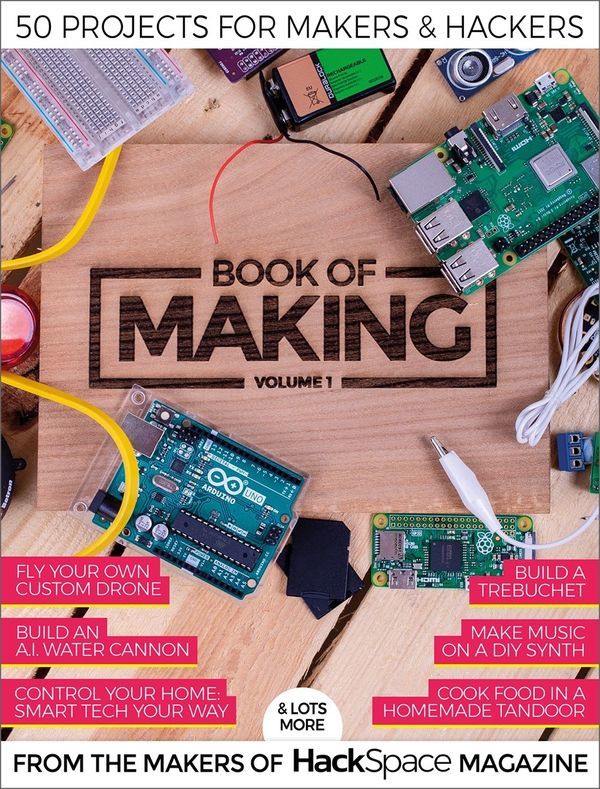
Book of Making volume 1
"We've gathered up our favourite projects from the first year of HackSpace magazine in one place – the Book of Making volume one. It's 184 pages of hands-on guides, tips, tricks, and inspiration. We show you how to build a tandoor, create your own drone, target your enemies with a face-tracking water gun, and much more. Whether you've got an hour to build something or you're looking for a weekend project, we've got a range of makes to choose from. " [...]
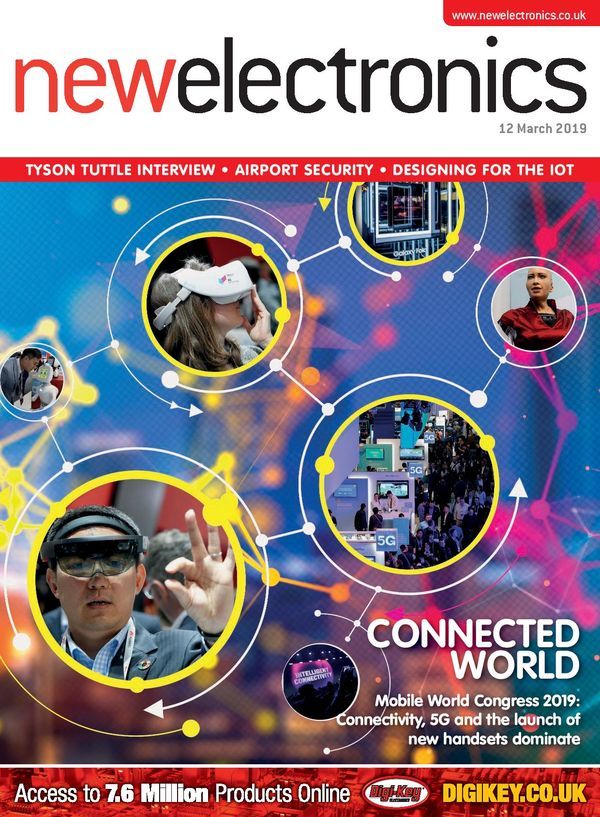
newelectronics 12 Março 2019
"New Electronics is a fortnightly magazine focusing on technological innovation, news and the latest developments in the electronics sector. Downloadable as a digital page turner or pdf file, or offered as a hard copy, the New Electronics magazine is available in a format to suit you" [...]

newelectronics 26 Março 2019
"New Electronics is a fortnightly magazine focusing on technological innovation, news and the latest developments in the electronics sector. Downloadable as a digital page turner or pdf file, or offered as a hard copy, the New Electronics magazine is available in a format to suit you" [...]

Inside Azure Management
"Inside Azure Management” is the sequel to “Inside the Microsoft Operations Management Suite”, featuring end-to-end deep dive into the full range of Azure management features and functionality, complete with downloadable sample scripts. " [...]
Projetos Maker
Diversos Projetos interessantes.
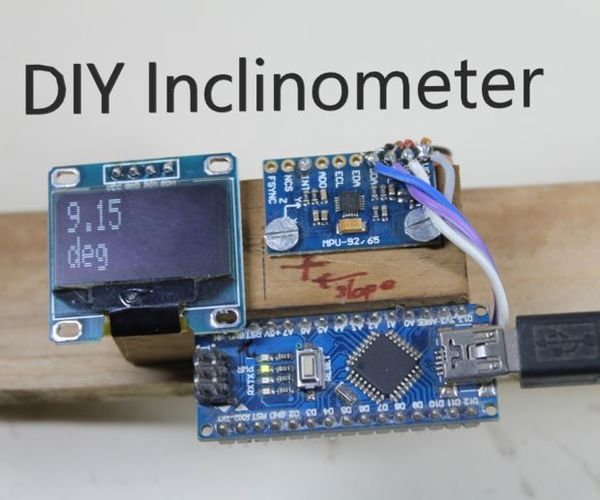
DIY Inclinometer
"As you might have guessed by looking at the photos, this device helps you measure the angle of a surface with respect to earth's gravitational field. In a nutshell, if i=the device measures an angle of 0.0something degrees it means you have done a nice job at leveling the desk. In this instructable I will take you through the steps that I followed to make this awesome project. I hope you will like it. The list of components is fairly straight forward. A simple arduino, (Nano in my Case), MPU 9250 IC, and an OLED display to output the data." [...]
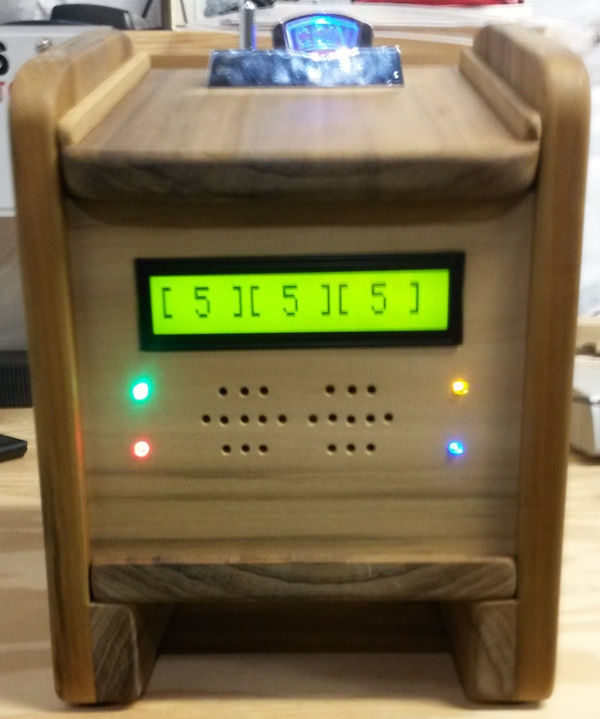
Slot Machine
"I remember when I was a 17-year-old, recent high school graduate, and was traveling with my grandparents from California back to their home in Michigan. Of course we stopped in Las Vegas and walked the Strip just to see what there was to see. Almost all of the casinos were open at the front so I wandered into one with my grandparents. I saw a nickel slot machine and just had to stick a coin in. Surprise, surprise, I hit the jackpot! Jackpots were paid out as two rolls of 50 nickels each so a casino employee came over when the lights and sound went off." [...]
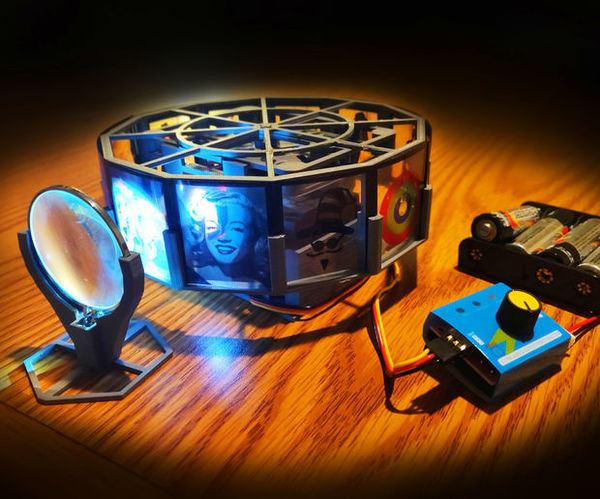
3D Printed Projector | Geneva Drive
"I saw a video about the Geneva Drive by Makers Muse on youtube and on Instructables but it was only used as a demonstration. The Geneva Drive holds it's position before quickly turning to the next position. I was inspired by this and I did my best to redesign and remix this 6 position Geneva Drive into a 3D printed 12 frame automatic projector! " [...]
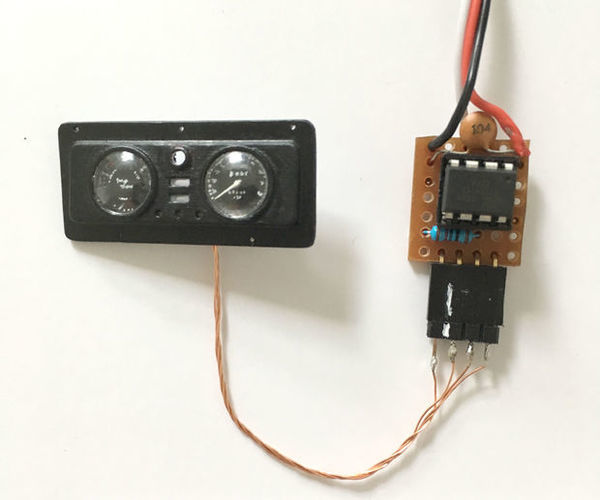
Working RC Car Speedometer
"This is a short project that I created as part of a larger RC build of a Lightweight Land Rover. I decided that I fancied having a working speedometer in the dashboard, but I knew that a servo wouldn't cut it. There was only one reasonable option: deploy the arduino! A bit of background to begin with... I am not a coding or electronics person. I still think of electricity in terms of water flow and am somewhat mystified by resistors." [...]
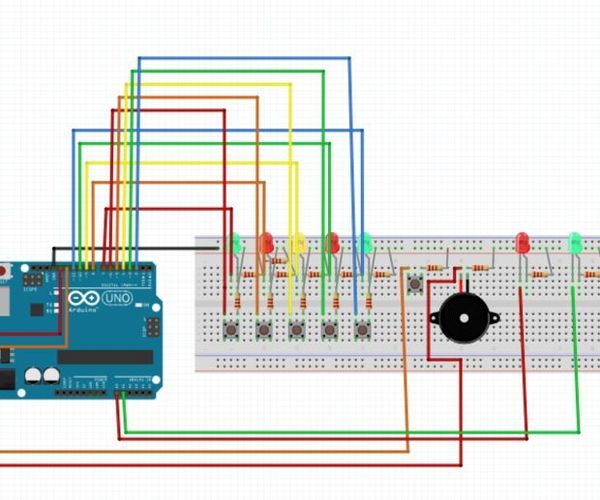
Arduino: Game Using LEDS
"This Arduino project is a simple memory game using LEDS. To play the game you need to press the button on the upper right area and a chain of 5 LEDS will light up. In order to win you will need to press them in the exact same order. You will be able to tell if you got it right from the two red and green LEDS to the right. Finally you can change the speed that the LEDS light up and how many light up each round to make the game a bit more challenging. " [...]
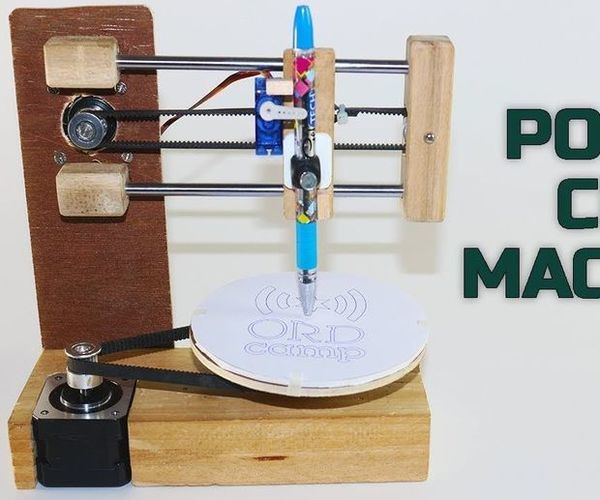
How to Make Polar CNC Drawing Machine
"Hello friends welcome back in this new instructbales Here I have made a simple Polar CNC drawing machine, I kept is as simple as possible complete structure is made out of wood. I avoid to use 3D printer to keep it simple, so anyone can made it. So basically you think what is polar CNC means, so I will tell polar CNC's are quit different in comparison of traditional CNC, Polar CNC are work in 360 degree format while traditional CNC are work in Cartesian coordinate system like X, Y & Z axis. In this this machine the Y axis (turn table) is polar format," [...]
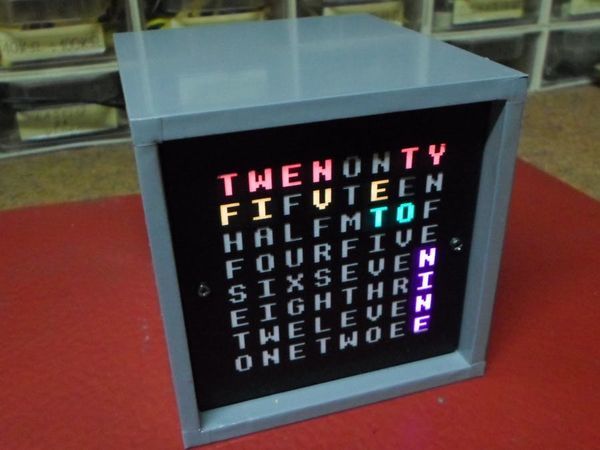
Arduino Word Clock on 8x8 RGB LED Matrix
"This is probably the best project that can be done with this module. Some time ago, I ordered from eBay: "Full-color RGB 8x8 LED+Colorful Magic Matrix Driver shield Colorduino KIT DIY" which is also known as "Funduino," consists of the 8x8 RGB LED matrix and driver shield (control board with atmega chip and LED drivers). This is probably the best project that can be done with this module. There are many projects on the Internet that are just pattern generators and nothing more. Mark Wilson made an intuitive word clock, and even wrote his own library "chromaduino" which you can find at GitHub: https://github.com/funnypolynomial/Chromaduino It drives the LEDs and receives display information from a master over I2C. Now I will try to explain step by step the construction of this device." [...]
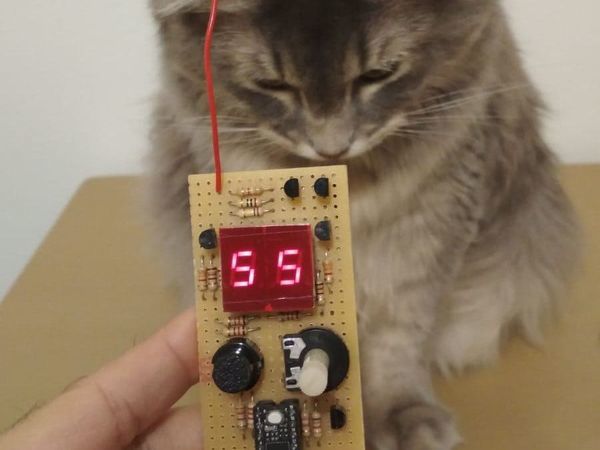
electrostatiCAT
"Measure electrification when you're petting your cat. Introduction Some cats tend to be so electrostatic, that I often get shocked when petting them. :) I just wanted to create a funny and rather useless tool, that allowed to measure the electrification when you pet them! Of course this is not a precise meter. The value displayed is just in arbitrary units! I used uChip, but you can use anything that has an ADC and enough GPIOs." [...]
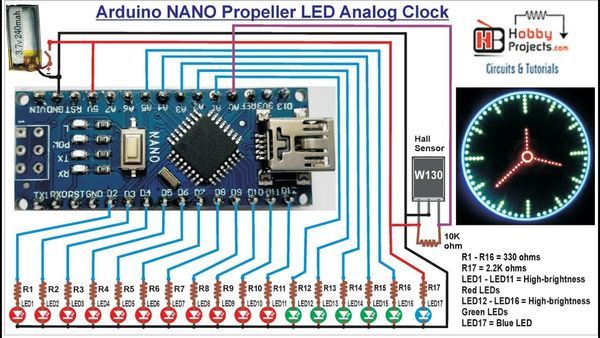
Arduino NANO Propeller LED Analog Clock
"In this video you will see the Arduino UNO Propeller LED Analog Clock using Arduino UNO, Hall Sensor, magnet, LEDs and Resistors. " [...]

Automatic Fume Extractor
"Hack a cheap smoke detector to automatically extract smoke, carbon monoxide and solder fumes! Introduction I'm currently doing a lot of PCB assembly in work and I find the soldering fumes irritate my eyes and lungs.Using a cheap smoke detector, we can use its piezo buzzer output to drive a MOSFET switched extractor fan. This same design could be used to ventilated a room in the event of a fire or if carbon monoxide is detected! Parts needed Full parts list in BOM attached. P-channel power MOSFET (IRF9530) NPN transistor (C549C) Battery powered smoke detector (optical or ionisation) 9-12V @1A+ power supply or suitable battery Bridge rectifier (4x general purpose diodes) Assorted capacitors Assorted resistors Assorted diodes Perf board to assemble circuit OR purchase pre-populated PCB Hacking the smoke detector The IC on the board is a Shanghai Belling BL59S10. This IC contains all functions needed to detect smoke, drive the piezoelectric buzzer and handle alarm interconnections." [...]
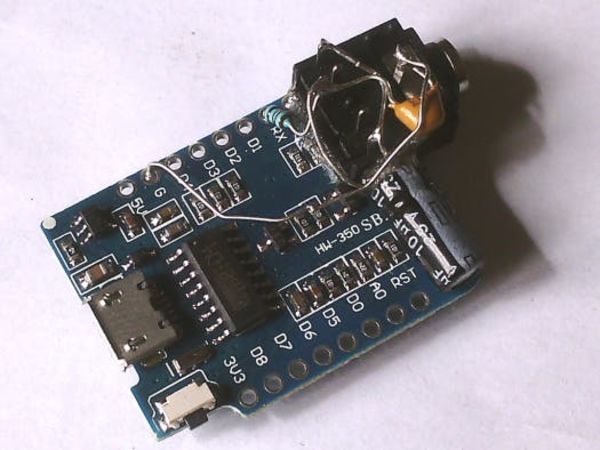
Audio Hacking on the ESP8266
"Building synthesizers on the ESP8266. The ESP8266 is quite powerful for audio applications with a CPU frequency of 160MHz and 4MB flash. The goal for this tutorial is to build synthesizers on the ESP8266 platform so we will also go through adding MIDI inputs. The PDM DAC can also be used for webradio and other audio streaming applications. We will use the Wemos D1 Mini board with the Arduino IDE. " [...]
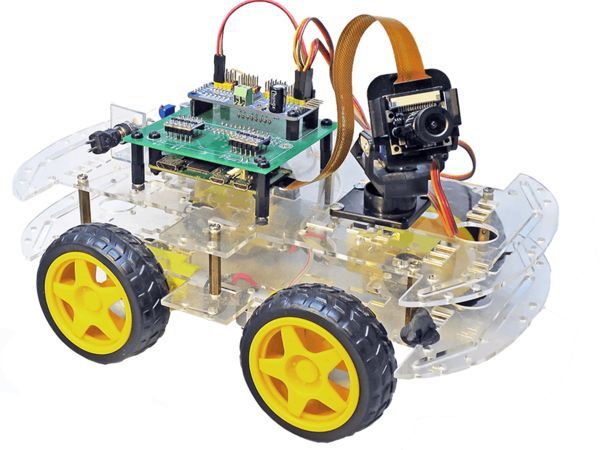
Raspberry Pi Car with FPV Camera Controlled by a Smartphone
"In this article, I will demonstrate how to make a robot car controlled using web browser (also mobile browser ) with camera preview. About tutorial In this article I will demonstrate how to make a robot car controlled using web browser. It will also stream a video feed using a camera connected to the car. You don’t have to be an expert to make this robot. All the required code is already available on RemoteMe. At the bottom of the post, the principle of the car’s operation is described in more detail." [...]
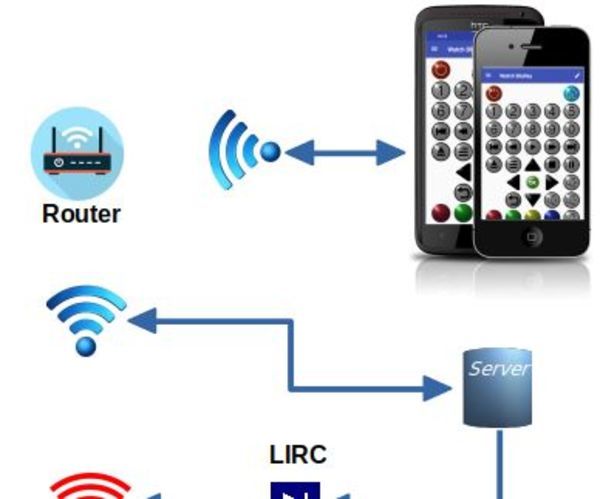
AndyMOTE Server
"I wanted a universal remote control for my mancave and figured that I should be able to do this with an app on my mobile phone (to provide the User Interface) and a Raspberry PI to provide the Infra Red 'Blaster'. After a little investigation I discovered the LIRC project which looked ideal for the 'Blaster'. I wrote my own Android App (AndyMOTE) and a small 'Server' Program to provide an interface between the two. This instructable shows you how to build the server" [...]
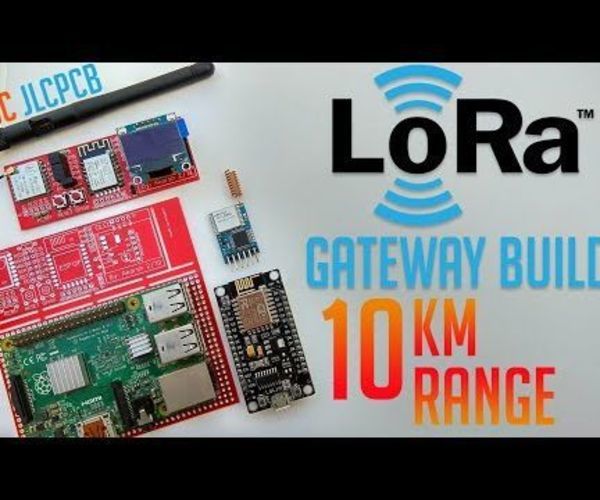
15$ LoRa Gateway/Node ESP8266 Build PCB 3cmX8cm Size
"Hey, what's up, guys? Akarsh here from CETech. Today we are going to make a project which is a simple LoRa node and you can even use it as a single channel gateway. Here the microcontroller that I used is the ESP8266, which is connected to LoRa boards of 433MHz(Ra-02 by Ai-Thinker), I have also attached an OLED display to the PCB so that the packet information is visible. To make things simpler I have designed a PCB which you can get manufactured for soldering. I have also made a video about building this project in detail, I recommend watching that for better insight and detail." [...]
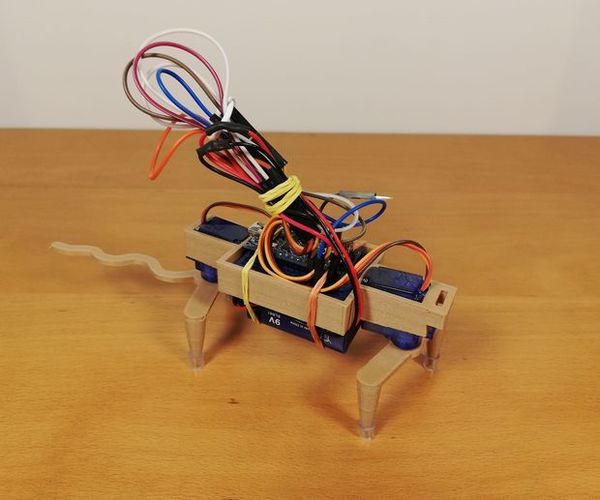
Robotic Rat
"I have been building robots and fixing old computers for some time now and my robotics teacher told me that it was good time to start sharing with other people what I have learnt. So here we go! One day a friend of mine gave me a 3D model to build a robot and some components: One arduino nano microcontroller and two servo motors, with these 3 things I started to build my little robot. In this Instructable I am going to share with you how to make this robot, also I will include the 3D model and the code that I have written, so you can have all that it is needed to make your own robotic rat! " [...]
Arduino MIDI Controller DIY
"Hey guys! I Hope you already enjoyed my previous instructable "Arduino CNC Plotter (mini drawing machine)" and you are ready for a new one, as usual I made this tutorial to guide you step by step while making this kind of super amazing low cost electronic projects which is the "Midi Controller". During the making of this project, we tried to make sure that this instructable will be the best guide for you in order to help you if you want to make your own MIDI controller, so we hope that this instructable contain the needed documents. This project is so handy to make specially after getting the customized PCB that weve ordered from JLCPCB to improve the appearance of our machine and also there is enough documents and codes in this guide to allow you create your midi controller easily. We've made this project in just 3 days only, just three days to get all the needed parts and finish the hardware making and the assemble, then we have prepared the code to suit our project. Before starting lets see first What you will learn from this instructable: Making the right hardware selection for your project depending on its functionalities.Prepare the circuit diagram to connect all the choosen components.Assemble all the project parts (mechanical and electronic assembly).Setup the appropriate software for the midi controller.start your own MIDI display." [...]
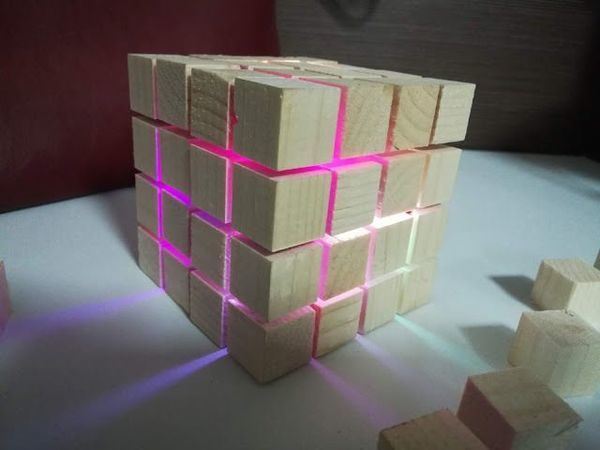
Sound Reactive Light Cube , Featured in Hackspace
"IntroductionToday we are going to make a sound Reactive wooden cube. Which will be changing color in perfect sync to the surrounding sounds or vibration. Featured in #Hackspace 16th issue https://hackspace.raspberrypi.org/issues/16 Hardware required Arduino Nano Addressable UCS1903B DC5V Mic based Sound Sensor Module White Wood Cube Theory The sounds will be picked by the mic module and will be amplified and fed to the Arduino analog pin, we will read the analog pin values and using the fastLED library we will change the colors of the LEDs randomly according to the received values from the mic. " [...]
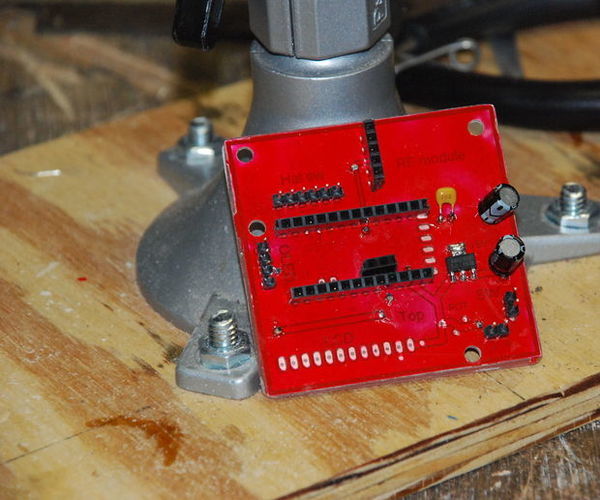
Printed Circut Boards - Complete Process
"The following describes the process by which I create PC circuit boards for one-offs and prototype use. It is written for a person who has created their own boards in the past and is familiar with the general process. All of my steps may not be optimal for your situation. I have developed this process by trial and error incorporating techniques from various sources. Please take whatever works for you and discard that which does not. A production note: I am old school and learn best from written instruction and pictures, they form the bulk of this instructable, I have included a couple of videos for some of the more complex steps." [...]
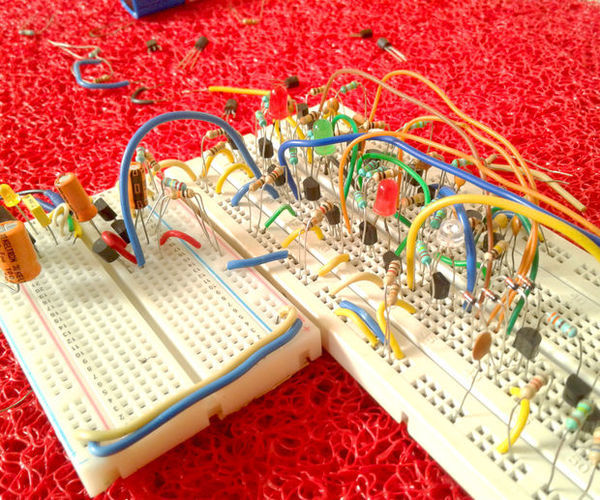
BCD Counter Using Discrete TRANSISTORS
"Today in this digital world, we creating different types of digital circuits using ics and micro-controllers. I also created tons of digital circuits. In that time I think about that how these are made. So after some research I find that these are designed from the basic electronic components. So I am very much interested in it. So I plan to make some digital devices using discrete components." [...]
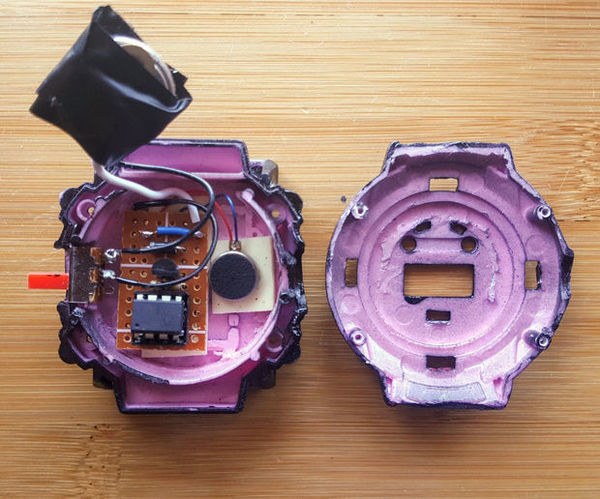
Vibrating Watch to Remind Wearer Not to Waste Time
"Everyone knows that time is both fleeting and limited. And yet we still forget this simple truth and continue to waste time on unimportant things. I created a watch that would vibrate every 5 minutes to constantly remind me to not waste precious time procrastinating. This watch is different from a traditional watch as it only informs the wearer on the passage of time instead of the current exact time. I now wear this watch all the time and it has improved my daily productivity. I hope that this instructable would also help you in making better use of your time." [...]
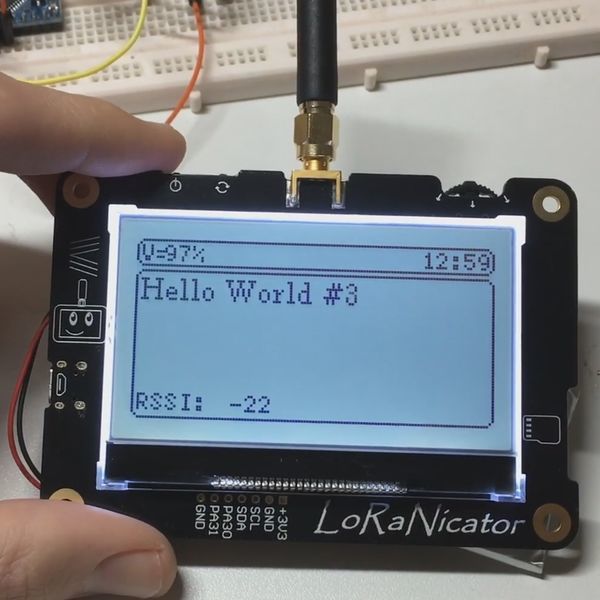
LoRaNicator
"A wireless telecommunications device, based on LoRa technology, that receives and displays alphanumeric messages. LoRaNicator is a pager devices based on LoRa technology. - 128x64px monochrome LCD with build in ST7565R-G Controller - ATSAMD21G18A-AU Cortex-M0+ 32bit low power ARM MCU (Arduino compatible) - Extremely Accurate I2C RTC - On-Board Single-Cell Li-Polymer Charge Management Controller - Smart push-button on/off controller - Micro SD-Card Slot - RFM95W LoRa Transceiver (868MHz or 915MHz) - 3-way Navigation Switch - High-Efficient Buck-Boost Voltage Converter - On-Board Coin Pager Motor - On-Board Piezoelectric Sounder - GPIO Header for External Periphery - 2-Layer PCB - Dimensions LxWxH (mm): 100x78x14 (without battery incl. SMA 8mm connector) - Open Source Hardware" [...]
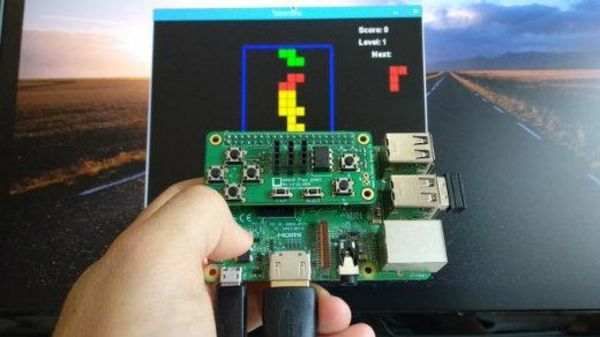
How to make a Raspberry Pi gamepad
"This DIY retro video game controller for the Raspberry Pi is fun and not difficult to build but requires some time. From time to time, I get nostalgic about the video games I played during my childhood in the late '80s and the '90s. Although most of my old computers and game consoles are long gone, my Raspberry Pi can fulfill my retro-gaming fix. I enjoy the simple games included in Raspbian, and the open source RetroPie project helped me turn my Raspberry Pi into an advanced retro-gaming machine. But, for a more authentic experience, like back in the "old days," I needed a gamepad. There are a lot of options on the market for USB gamepads and joysticks, but as an open source enthusiast, maker, and engineer, I prefer doing it the hard way." [...]
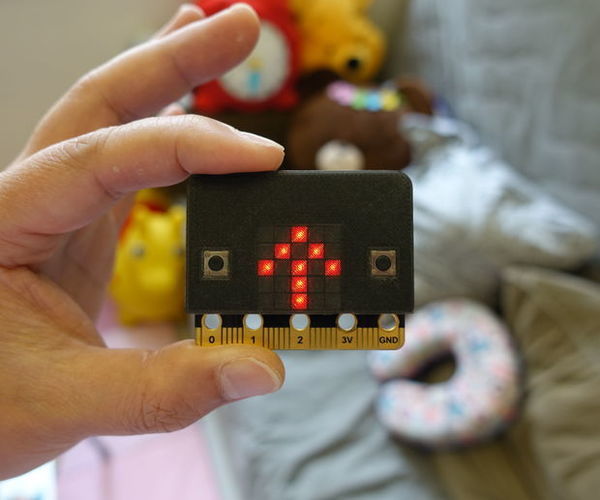
Micro:bit Compass
"This instructables show how to use micro:bit to make a simple digital compass. " [...]
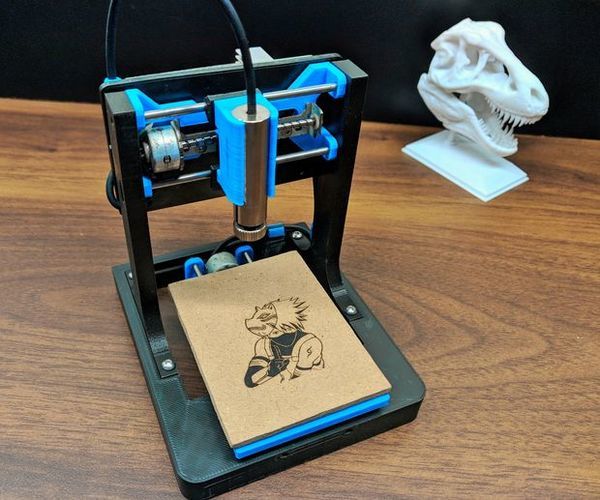
DIY Mini CNC Laser Engraver.
"This is an Instructables on how I Remixed my old CNC Laser engraver and made a Stable version of an Arduino based Laser CNC engraver and thin paper cutter using old DVD drives and using 250mW laser. Old Version of My CNC :https://www.instructables.com/id/Mini-CNC-Laser-Wood-Engraver-and-Paper-Cutter/ Old version was not much stable and had some wobble due to uneven parts, so I decided to make a stable version of it using 3D printed parts. Which gave me excellent results in laser engraving even in very tiny details, this machine is cable of doing the work well. You can see the details in the eye of the engraved picture. Playing area is 40mm x 40mm max. " [...]
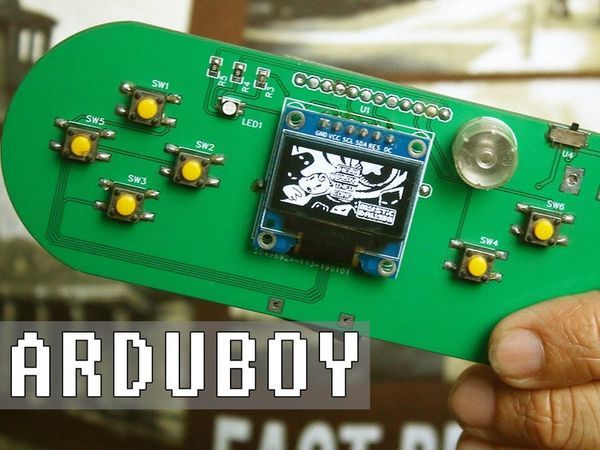
Handheld Gaming Console | Arduboy Clone
"Made my own version of Arduboy, from breadboard to printed circuit board! A few months ago I came across Arduboy which according to its official website is a miniature 8-bit game platform that makes it easy to learn, share and play games online. It is an open source platform. The games for the Arduboy are made by the users. Arduboy is based around ATmega32u4 which is the same microcontroller used in Arduino Pro Micro. Although I am not yet capable of making games, I decided to make build the hardware part of it on a breadboard." [...]
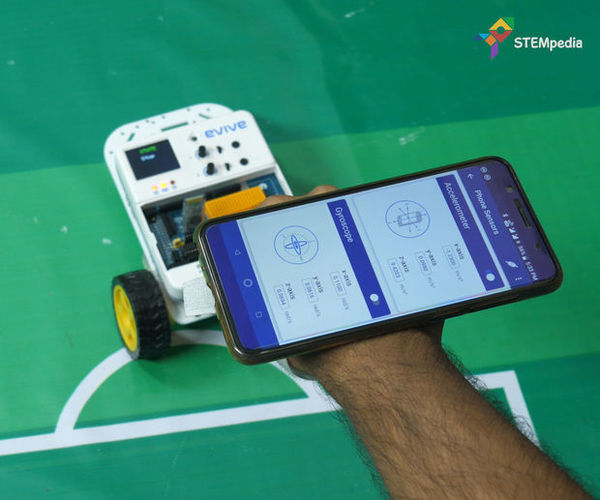
Making a Gesture Controlled Robot Using Your Smartphone
"Controlling robots with conventional controllers, be it handheld or a virtual one in your Smartphone, has become too mainstream. How about we go a step (or maybe two?) forward and use something different, such as hand gestures? Sounds interesting? Well, thats settled then! Were going to control our robot using a Smartphone; not by tapping some buttons but by moving our hand!" [...]
NeoPixel Clock With Alarm
"Hi guys, get up early in the morning is sometimes hard. Especially when it is cloudy, raining or winter outside. Since I made my own a clock with alarm, getting up is much more enjoyable for me. :) I used precise RTC module for controls the time and alarm. Two NeoPixel rings displays time ( btw. are you also fascinated by LED lights?" [...]
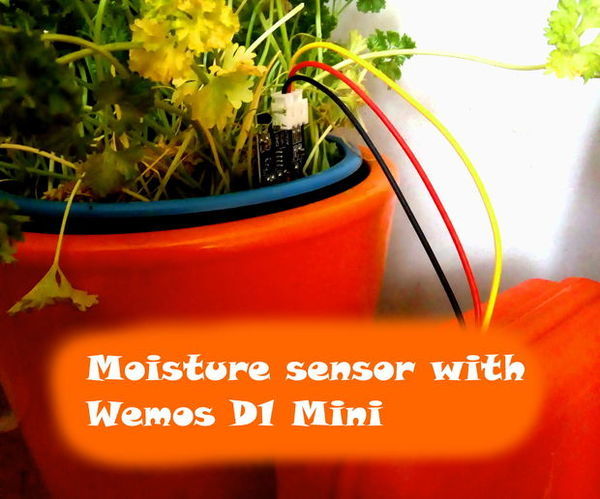
Wireless Moisture Monitor (ESP8266 + Moisture Sensor)
"I buy parsley in pot, and most of day, soil were dry. So I decide to make this project, about sensing moisture of soil in pot with parsley, to check, when I need pour soil with water. I think, this sensor (Capacitive moisture sensor v1.2) is good because: 1. has waterproof electrodes, so you don't worry about corrosion. 2. is cheap -> 1,5 - 2 $" [...]
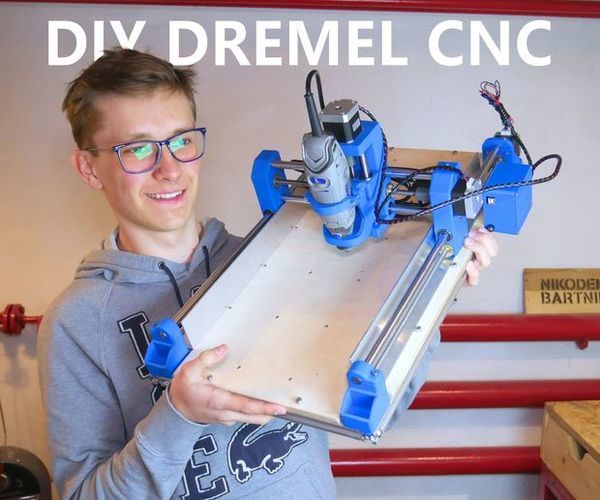
DIY 3D Printed Dremel CNC
"When I got my first 3D printer I was extremely happy with all the new possibilities to create things but after some time I noticed the limitations of 3D printing. Plastic is easy to melt, sometimes it's not mechanically resistant enough and most importantly sometimes doesn't look good. Don't take me wrong here, I love 3D printing and I like plastic (except plastic waste) but there are things that look, work or feel way better when made out of nonplastic material. Imagine all your furniture made out of plastic. Sometimes I prefer wood, when I need strength, metal (mostly aluminum) is a way to go. That's where CNC milling machines are used." [...]
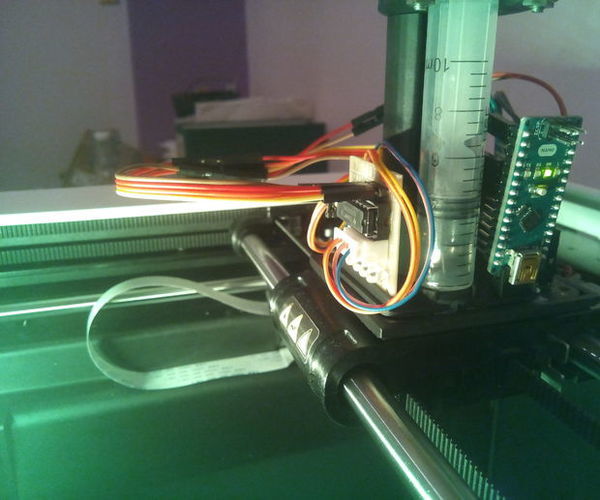
Solder Paste Dispensing Head
"This is a custom solder paste dispensing head that can be added on an existing CNC machine. The CNC machine, for which the dispensing head is currently developed, is a FABtotum multipurpose device (https://opentotum.github.io/fabtotum.com-backup/): CAD files for dispensing head come from a remix of TwinTeeth's dispensing head (http://www.diyouware.com/node/174), adapted onFABtotum carriage.A remix of CAM software rpt2pnp (https://github.com/hzeller/rpt2pnp) was adapted to fit the needs of FABtotum supported gcode commands.The PCB on which tests were made is an FTDI circuit (http://archive.fabacademy.org/2016/fablabsingapore/students/98/exercise06.html) designed with KiCAD (1206 Imperial).The PCB is milled with FABtotum using FlatCAM. An 20G 0.6mm ID 1.5'' dispensing needle is used to dispense diluted solder paste with IPA. " [...]
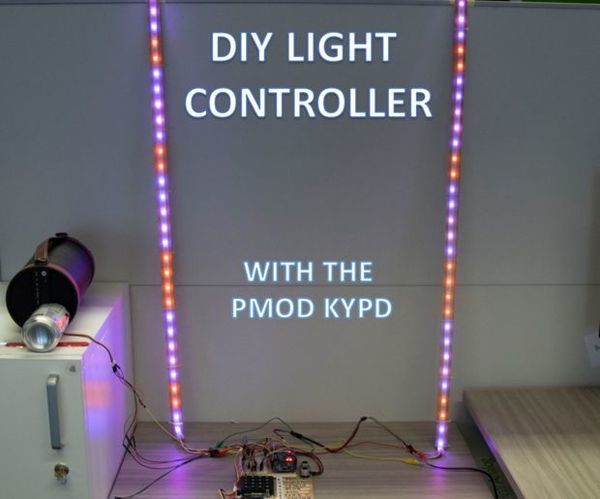
Translightion Board (Controllable Music Visualizer)
"Translate music to a dazzling light show with this customizable light controller project. Great for DJs, parties, and 1:1 shows! The idea behind this project was to create a controller to allows users to “play” light like it is an instrument with custom visuals, gesture control, and brightness/speed dials. Considering how pricey consumer light controllers can be (often $100 bucks or more- not including the lights!) we decided to try to make a cheaper, more customizable solution! " [...]
That's all Folks!


